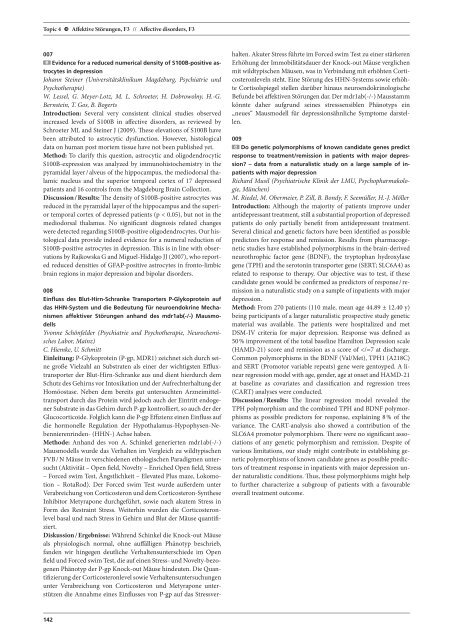Psychische Erkrankungen in der Lebensspanne ... - DGPPN
Psychische Erkrankungen in der Lebensspanne ... - DGPPN
Psychische Erkrankungen in der Lebensspanne ... - DGPPN
Erfolgreiche ePaper selbst erstellen
Machen Sie aus Ihren PDF Publikationen ein blätterbares Flipbook mit unserer einzigartigen Google optimierten e-Paper Software.
Topic 4 G Affektive Störungen, F3 // Affective disor<strong>der</strong>s, F3<br />
007<br />
Evidence for a reduced numerical density of S100B-positive astrocytes<br />
<strong>in</strong> depression<br />
Johann Ste<strong>in</strong>er (Universitätskl<strong>in</strong>ikum Magdeburg, Psychiatrie und<br />
Psychotherapie)<br />
W. Lessel, G. Meyer-Lotz, M. L. Schroeter, H. Dobrowolny, H.-G.<br />
Bernste<strong>in</strong>, T. Gos, B. Bogerts<br />
Introduction: Several very consistent cl<strong>in</strong>ical studies observed<br />
<strong>in</strong> creased levels of S100B <strong>in</strong> affective disor<strong>der</strong>s, as reviewed by<br />
Schroeter ML and Ste<strong>in</strong>er J (2009). These elevations of S100B have<br />
been attributed to astrocytic dysfunction. However, histological<br />
data on human post mortem tissue have not been published yet.<br />
Method: To clarify this question, astrocytic and oligodendrocytic<br />
S100B-expression was analyzed by immunohistochemistry <strong>in</strong> the<br />
pyramidal layer / alveus of the hippocampus, the mediodorsal thalamic<br />
nucleus and the superior temporal cortex of 17 depressed<br />
patients and 16 controls from the Magdeburg Bra<strong>in</strong> Collection.<br />
Discussion / Results: The density of S100B-positive astrocytes was<br />
reduced <strong>in</strong> the pyramidal layer of the hippocampus and the superior<br />
temporal cortex of depressed patients (p < 0.05), but not <strong>in</strong> the<br />
mediodorsal thalamus. No significant diagnosis related changes<br />
were detected regard<strong>in</strong>g S100B-positive oligodendrocytes. Our histological<br />
data provide <strong>in</strong>deed evidence for a numeral reduction of<br />
S100B-positive astrocytes <strong>in</strong> depression. This is <strong>in</strong> l<strong>in</strong>e with observations<br />
by Rajkowska G and Miguel-Hidalgo JJ (2007), who reported<br />
reduced densities of GFAP-positive astrocytes <strong>in</strong> fronto-limbic<br />
bra<strong>in</strong> regions <strong>in</strong> major depression and bipolar disor<strong>der</strong>s.<br />
008<br />
E<strong>in</strong>fluss des Blut-Hirn-Schranke Transporters P-Glykoprote<strong>in</strong> auf<br />
das HHN-System und die Bedeutung für neuroendokr<strong>in</strong>e Mechanismen<br />
affektiver Störungen anhand des mdr1ab(-/-) Mausmodells<br />
Yvonne Schönfel<strong>der</strong> (Psychiatrie und Psychotherapie, Neurochemisches<br />
Labor, Ma<strong>in</strong>z)<br />
C. Hiemke, U. Schmitt<br />
E<strong>in</strong>leitung: P-Glykoprote<strong>in</strong> (P-gp, MDR1) zeichnet sich durch se<strong>in</strong>e<br />
große Vielzahl an Substraten als e<strong>in</strong>er <strong>der</strong> wichtigsten Effluxtransporter<br />
<strong>der</strong> Blut-Hirn-Schranke aus und dient hierdurch dem<br />
Schutz des Gehirns vor Intoxikation und <strong>der</strong> Aufrechterhaltung <strong>der</strong><br />
Homöostase. Neben dem bereits gut untersuchten Arzneimitteltransport<br />
durch das Prote<strong>in</strong> wird jedoch auch <strong>der</strong> E<strong>in</strong>tritt endogener<br />
Substrate <strong>in</strong> das Gehirn durch P-gp kontrolliert, so auch <strong>der</strong> <strong>der</strong><br />
Glucocorticoide. Folglich kann die P-gp Effizienz e<strong>in</strong>en E<strong>in</strong>fluss auf<br />
die hormonelle Regulation <strong>der</strong> Hypothalamus-Hypophysen-Nebennierenr<strong>in</strong>den-<br />
(HHN-) Achse haben.<br />
Methode: Anhand des von A. Sch<strong>in</strong>kel generierten mdr1ab(-/-)<br />
Mausmodells wurde das Verhalten im Vergleich zu wildtypischen<br />
FVB / N Mäuse <strong>in</strong> verschiedenen ethologischen Paradigmen untersucht<br />
(Aktivität – Open field, Novelty – Enriched Open field, Stress<br />
– Forced swim Test, Ängstlichkeit – Elevated Plus maze, Lokomotion<br />
– RotaRod). Der Forced swim Test wurde außerdem unter<br />
Verabreichung von Corticosteron und dem Corticosteron-Synthese<br />
Inhibitor Metyrapone durchgeführt, sowie nach akutem Stress <strong>in</strong><br />
Form des Restra<strong>in</strong>t Stress. Weiterh<strong>in</strong> wurden die Corticosteronlevel<br />
basal und nach Stress <strong>in</strong> Gehirn und Blut <strong>der</strong> Mäuse quantifiziert.<br />
Diskussion / Ergebnisse: Während Sch<strong>in</strong>kel die Knock-out Mäuse<br />
als physiologisch normal, ohne auffälligen Phänotyp beschrieb,<br />
fanden wir h<strong>in</strong>gegen deutliche Verhaltensunterschiede im Open<br />
field und Forced swim Test, die auf e<strong>in</strong>en Stress- und Novelty-bezogenen<br />
Phänotyp <strong>der</strong> P-gp Knock-out Mäuse h<strong>in</strong>deuten. Die Quantifizierung<br />
<strong>der</strong> Corticosteronlevel sowie Verhaltensuntersuchungen<br />
unter Verabreichung von Corticosteron und Metyrapone unterstützen<br />
die Annahme e<strong>in</strong>es E<strong>in</strong>flusses von P-gp auf das Stressver-<br />
142<br />
halten. Akuter Stress führte im Forced swim Test zu e<strong>in</strong>er stärkeren<br />
Erhöhung <strong>der</strong> Immobilitätsdauer <strong>der</strong> Knock-out Mäuse verglichen<br />
mit wildtypischen Mäusen, was <strong>in</strong> Verb<strong>in</strong>dung mit erhöhten Corticosteronleveln<br />
steht. E<strong>in</strong>e Störung des HHN-Systems sowie erhöhte<br />
Cortisolspiegel stellen darüber h<strong>in</strong>aus neuroendokr<strong>in</strong>ologische<br />
Befunde bei affektiven Störungen dar. Der mdr1ab(-/-) Mausstamm<br />
könnte daher aufgrund se<strong>in</strong>es stresssensiblen Phänotyps e<strong>in</strong><br />
„neues“ Mausmodell für depressionsähnliche Symptome darstellen.<br />
009<br />
Do genetic polymorphisms of known candidate genes predict<br />
re sponse to treatment/remission <strong>in</strong> patients with major depression?<br />
– data from a naturalistic study on a large sample of <strong>in</strong>patients<br />
with major depression<br />
Richard Musil (Psychiatrische Kl<strong>in</strong>ik <strong>der</strong> LMU, Psychopharmakologie,<br />
München)<br />
M. Riedel, M. Obermeier, P. Zill, B. Bondy, F. Seemüller, H.-J. Möller<br />
Introduction: Although the majority of patients improve un<strong>der</strong><br />
antidepressant treatment, still a substantial proportion of depressed<br />
patients do only partially benefit from antidepressant treatment.<br />
Sev eral cl<strong>in</strong>ical and genetic factors have been identified as possible<br />
predictors for response and remission. Results from pharmacogenetic<br />
studies have established polymorphisms <strong>in</strong> the bra<strong>in</strong>-<strong>der</strong>ived<br />
neurothrophic factor gene (BDNF), the tryptophan hydroxylase<br />
gene (TPH) and the seroton<strong>in</strong> transporter gene (SERT; SLC6A4) as<br />
related to response to therapy. Our objective was to test, if these<br />
candidate genes would be confirmed as predictors of response / remission<br />
<strong>in</strong> a naturalistic study on a sample of <strong>in</strong>patients with major<br />
depression.<br />
Method: From 270 patients (110 male, mean age 44.89 ± 12.40 y)<br />
be<strong>in</strong>g participants of a larger naturalistic prospective study genetic<br />
material was available. The patients were hospitalized and met<br />
DSM-IV criteria for major depression. Response was def<strong>in</strong>ed as<br />
50 % improvement of the total basel<strong>in</strong>e Hamilton Depression scale<br />
(HAMD-21) score and remission as a score of


